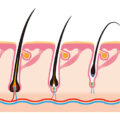Last updated on June 3, 2024
Will a hair transplant last forever?
A hair transplant can be permanent- lasting a long time >20 years and in most cases for life. How does this work? When we experience male-pattern hair loss, it always happens up the top of the head and not on the sides. The hairs growing up top are genetically different from the rest and are prone to thinning and falling as we age. So, by transplanting the hairs from the back to up top, you effectively implant follicles resistant to the same thinning and loss.
Hair transplantation relocates lifelong hairs not subject to the hair loss process from the back and sides of your head to areas you are balding. These lifelong hairs keep their longevity when transplanted to a new location in the scalp – this is why a hair transplant can be a permanent solution to balding. However, there is a common misconception that new, transplanted hair that grows after surgery will fall out permanently! This is simply not true.
That being said, you need to be proactive about retaining the health of the rest of your hair up top—the hair that resided there in the first place. That hair can and will continue to thin and recess if you don’t treat it carefully. – Most hair transplant surgeons encourage PRP (Platelet Rich Plasma) or a medication regimen following your transplantation.
Am I a good candidate for hair transplantation surgery?
The ideal candidate for hair restoration surgery has healthy hair on the sides and back of the head. These sites are used as donor areas for the grafts. Men and women with well-defined baldness, thinning hair and those with limited hair loss due to scalp injuries or repeated cosmetic procedures are generally good candidates for hair restoration surgery. The NHC team will advise you of treatment options during an initial consultation.
Does the procedure hurt?
Within a week of the transplant, you can return to work, and the scabs typically fall out between days 7-12. The only pain you should feel is when you are initially numbed in the beginning. Afterwards, you’ll have the appropriate painkillers to navigate the next day or so until it all feels normal. Some swelling is mitigated with a headband for three days, so don’t plan to return to the office immediately.
You have to limit certain behaviours for the first month (like high water pressure, excessive sweating, intense physical activity), as well as direct sun exposure to the area for two months. Within 3-6 months, you’ll start seeing results; those hairs will be thin for a few months, as is any hair that regrows after falling. But after a year, you’ll see the full, thick hair.
Will you need a second hair transplant?
Some individuals sometimes have to undergo more than one hair transplant in their lifetime. This can be thickening a previously transplanted area, treating a new site that is already bald, or transplanting hair into an area that was not treated and continues to lose hair.
Your hair transplant may start to look out of place if you recede behind your implanted hairs. This might mean you opt to have a second or a third hair transplant if you are not taking medications or receiving PRP to prevent further hair loss.
Because a Hair Transplant can last for a lifetime, you need to be aware that if you continue to bald behind your transplant, your hair transplant will look odd in years to come. This is why it is important to consider starting and continuing hair loss preventative medication.
If you decide not to take any medication and only opt for a hair transplant, wait until your hair loss stabilises at the age of 30 before having the procedure. This is important because you can plan what you will need from a hair transplant and have an idea how much more hair you are likely to lose.
In some patients, a hair transplant lasts a long time, but they continue to thin in certain areas of the scalp. This may mean that a second or third hair transplant is required to top up specific areas in order to maintain a result. This can only be carried out a certain number of times before the donor area becomes thin. It is therefore best for patients who are looking at a hair transplant to understand that in order to prevent further hair loss, some treatments, such as medication and PRP will be required.
Following your procedure, New Hair Clinic will support you with a post-procedure treatment plan, designed to support long-term results.
If you are considering a hair transplant, our experienced medical team can speak with you to determine the best treatment options. To book an appointment, please contact us.
[/fusion_text][/fusion_builder_column][/fusion_builder_row][/fusion_builder_container]








